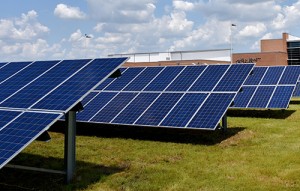
SALISBURY — On a bright, sunny summer day, the new solar energy system at James M. Bennett High was put on the Delmarva Power grid, and the school system began spending less on energy.
The 500-megawatt solar system at James M. Bennett High – located between the bus loop and the stormwater management pond off Olney Road – became fully operational on July 20. In its first days of operation, energy management staff could see from the energy reports they receive that the school’s solar was producing much more energy than the school was using. That’s important for shaving energy bills whenever possible, but it’s also important because at high demand times that school is no longer drawing from the region’s heavily used power grid. With one entire school of 1,500-plus people now off the power grid, that means less of a chance the community would experience rolling blackouts to reduce energy demand.
“Through the responsible use of electricity, we are doing our part to reduce the likelihood of blackouts in this area of the Eastern Shore,” said James C. Urbanski, Energy Manager.
Wicomico County Public Schools staff has monitored solar energy for several years, watching from a price perspective for a time when producing solar energy would be doable. Solar systems have become more efficient and affordable in recent years. Then in December 2013, Wicomico County began writing a contract with Solar City; the contract was signed in September 2014. The school system was included in the contract discussions as a potential user, and the exploration for suitable sites grew from there. The school system signed its own contract with Solar City, and installation began in spring 2015.
Not every school has the right space or the right orientation for an array of ground-mounted, stationary solar panels, which are the most affordable type of solar panels to install. In addition to the amount of open land that is needed for the system, the parcel had to face south, could not have any potential tree line intruding, and could not be in the way for future expansion of a school building.
So far, two schools have been identified as suitable solar sites. James M. Bennett High’s solar system began producing energy in July, while the system at Northwestern Elementary, by the ballfields, is ready to go on the grid in August.
“We have a fixed, firm kilowatt per hour price for a 20-year term, with no escalation in the contract,” said Mark Miller, procurement manager. “We had no capital costs. We provide the land for the solar array and agree to buy all the energy that is produced, for 4.5 cents per kilowatt hour. That’s great because the wholesale energy price we pay as a member of the Eastern Shore of Maryland Energy Consortium is 8 cents per kilowatt hour. In return, Solar City builds, operates, and maintains the solar system. When the amount of energy produced at a site like James M. Bennett High is more than the amount of energy the school uses, credit for the surplus energy is stored and may be used at other Wicomico school system sites, further saving on energy costs.”
For the past several years, Wicomico County Public Schools has been holding down summer energy usage – and therefore energy costs – by carefully following an energy conservation program. Summer building use must be submitted in the spring for review and approval, and air conditioning is only provided from 7 a.m. to 3 p.m., the time when peak demand and higher costs become a factor. Wicomico Schools also receives quarterly payments from vendor EnerNOC, which reduces the school system’s power consumption at high summer demand times.
Wicomico Schools also has solar at the new Bennett Middle School, which this month achieved LEED (Leadership in Energy & Environmental Design) Gold certification; a minimum level of LEED Silver was required by the state. Bennett Middle is the first school in Wicomico County to achieve LEED Gold. It is one of only three Gold schools on the Shore, and one of only 18 Gold schools in the state. Among its many energy smart features are solar preheating of domestic hot water for use in the school, and a small 50-kilowatt roof-mounted photovoltaic system to generate electricity behind the meter, for use on site.
